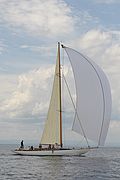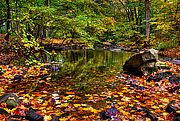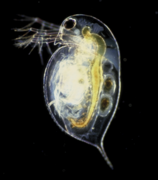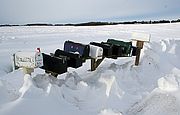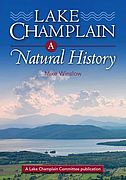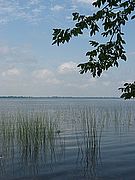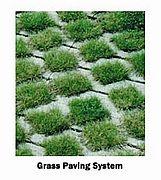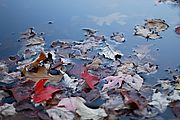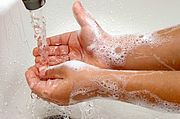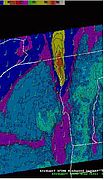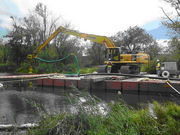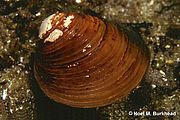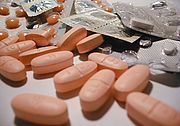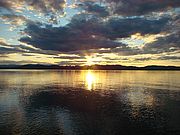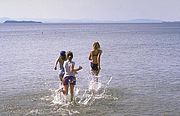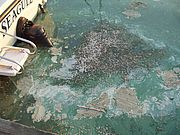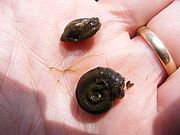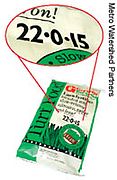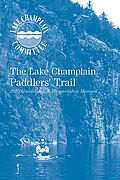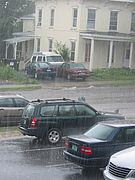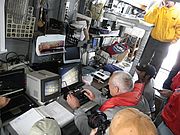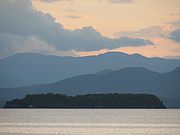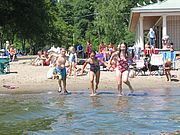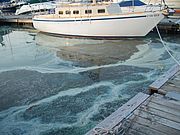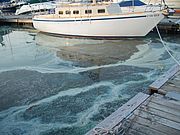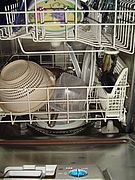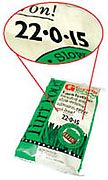LCC received a $1,500 gift from our friends at the Regatta for Lake Champlain. Established in 2004, the Regatta is a fun annual sailing event that raises funds to support organizations working to promote the health, well-being and sustainable use of Lake Champlain. Over the years, donations from the Regatta have helped fund LCC’s blue green algae monitoring program, maintain the Lake Champlain Paddlers’ Trail, and expand our stewardship efforts. Read...
News from Selected Month
Autmn’s panoply of colors blankets the mountains of the Champlain Valley. All summer the trees have been investing in short-term high-yield leaves to collect sunlight, and then placing the dividends in long-term wood. Now, they’re dumping their investment before the inevitable downturn, knowing that winter’s snow and winds would be more likely to pull down good wood if they tried to hold onto their leaves. Many of those leaves will end-up in headwater streams of Lake Champlain where they represent the primary energy input for the river system. Read...
On Lake Champlain we have become accustomed to winters when the lake no longer freezes over completely. From the mid 1800s, the time of the first available records, until the 1950s it was almost a given that the lake would freeze over each year. Since then, on average the lake freezes every other year. However, on many lakes freeze over is still a regular occurrence, and a recent report from Germany suggests that when lakes that regularly freeze do not, the results can be dramatic. Read...
If you’ve had an address change recently, please send us an email so we can correct your files and ensure that we keep you updated on lake issues and LCC’s work. LCC’s primary form of communication with members is through email. By mailing electronically we save time and resources and reinforce the stewardship ethic of our mission. We don’t give away or sell email addresses. To ensure that our email messages get through to your inbox, please add lcc@lakechamplaincommittee.org and the domain enews.lakechamplaincommittee.org to your safe/allowed list and address book. Read...
This Sunday, October 10, you can be part of a global work party of grassroots efforts to implement climate solutions. The idea initiated from climate crusader, international environmental activist author, and Champlain Valley resident Bill McKibben through 350.org. From conducting energy audits and planting community gardens to installing CFL light bulbs and lobbying Congress, citizens are getting to work... Read...
What happens to all the leaves that fall into the Champlain Valley’s rivers during autumn as they make their way to Lake Champlain? Why does a thin line of clouds appear over the lake on crisp October days? Why do you sometimes notice a stale rotten smell around the lake in late autumn?... Read...
The International Joint Commission (IJC) will hold two public meetings to discuss progress on identifying important land areas contributing to the pollution of Missisquoi Bay. The meetings will be October 12th in Swanton at the Village Municipal Complex (120 First Street) from 7:00 – 9:30 PM starting at 7PM and October 13th in St. Armand at the Community Center (444 Chemin Bradlee) from 6:00 – 8:30 PM... Read...
Some of the water quality problems that plague Lake Champlain, begin in our own backyards. Find out what you can do to reduce pollutant loading from your property at a free public workshop focusing on... Read...
October is usually the month when Lake Champlain reaches its lowest levels. The average lake level for October is 95.03 feet. Water evaporates throughout the heat of the summer. When plants are growing they transpire water through their leaves leaving less to go into rivers and streams... Read...
The presence of pharmaceuticals and other “new generation” contaminants in surface waters of the United States has been well documented. In Lake Champlain, for example, researchers have found caffeine, HHCB (a musk fragrance), metolachlor (an herbicide). Effects are not well known... Read...
On October 31, 2009 winds buffeted the Champlain Valley stirring the leaves of Halloween. The winds were sustained over a twelve hour period. The next day, the Plattsburgh Press Republican reported wind damage from throughout Essex and Clinton Counties. The cause of the winds was a low-level jet that had developed over Lake Champlain... Read...
Landlocked Atlantic salmon head from Lake Champlain into tributaries to spawn during the fall. The main run of salmon usually extends from early September into mid-November... Read...
The underwater cap at the Burlington Barge Canal Superfund Site is being repaired to ensure that contaminants don’t migrate to Lake Champlain. The $3.5 million sand and silt cap, originally installed during 2003 and 2004, has been largely effective... Read...
The presence of a new exotic species, Asian clam, has been confirmed in Lake George, NY. Lake George drains directly to Lake Champlain via the LaChute River. The thumbnail-sized Asian clam, blamed for clouding Lake Tahoe in the High Sierras... Read...
New York State has passed a bill regulating the use of phosphorus by homeowners. As of January 1, 2012, homeowners and landscape contractors will not be able to apply fertilizer containing phosphorus to their lawns in the absence of a soil test that demonstrates a need for phosphorus or if a new lawn is being established. LCC recommends always getting a soil test...
Not sure what to do with leftover medicines collecting in your cabinet? The U.S. Department of Justice Drug Enforcement Administration is sponsoring a nationwide collection event for unused, unwanted or expired drugs. On Saturday September 25 from 10:00 to 2:00 there will be free, anonymous drop-offs at numerous locations throughout the basin on both sides of the lake. Drugs and pharmaceuticals that are disposed of improperly can pass through sewage treatment plants and end up in the lake unchanged. Don’t flush unused medicines down the toilet or put them in the trash, bring them to a “Take Back” event for safe disposal. To find a collection site near you, just type in a zip code or city at this web page link: www.deadiversion.usdoj.gov/takeback/. Check your medicine cabinets and spread the word. Read...
A friend recently commented on how different the water of Lake Champlain looked compared to the famous deep blue color of the Mediterranean Sea. The observation prompted me to remember the turquoise of the lakes in Glacier National Park in Montana... Read...
Come play in, on and around the lake with LCC on Saturday, August 28th from 10:00 AM until 2:00 PM at beautiful Oakledge Park in Burlington. We’ll have delicious food from local purveyors, lake news, a “State of the Lake” report, and plenty of opportunity for discussion and play in a great park. The gathering is free and open to the public but there is a small fee for parking. Click on the heading for further details and directions. Read...
Eurasian water milfoil (milfoil) is the bane of many a lake user. This aggressive non-native plant invades lake systems and spreads prolifically, choking out other plants and making swimming, boating, and fishing... Read...
What animal is more humble than a snail? They are the epitome of slowness. The dull-colored shells are easily overlooked within the lake and rarely studied, but snails are a source of food for 20% of freshwater fish species including sunfish and perch. There are approximately... Read...
If you’re thinking of fertilizing this fall, take time now to get a soil test to find out what it needs and help protect our waterways. Fall, not spring, is the best time to fertilize lawns in the Champlain Valley. You can obtain soil test kits through your area Extension Agency or by stopping by the LCC office...
Read...Get your copy by joining LCC or renewing your membership!
The 2010 edition of the Lake Champlain Paddlers' Trail Guidebook and Stewardship Manual is out! It’s jam-packed with important information for great adventures on the water including site descriptions and chartlets for 39 Trail locations (including several new sites!), launch site listings, natural history articles...
The Nature Conservancy (TNC) recently released a report titled “Climate Change in the Champlain Basin: What natural resource managers can expect and do,” one of the first efforts in North America to assess climate change on a watershed scale and offer adaptation strategies. LCC Staff Scientist Mike Winslow served as a reviewer on the report... Read...
On June 15th, a team with representatives from the EPA, Lake Champlain Maritime Museum, the McAllister Company and Phoenix Engineering conducted an observation of the sunken tugboat William H. McAllister. The team used a remotely operated submersible vehicle to search...
Read...The Department of Energy has determined that an Environmental Impact Statement (EIS) will be required... Read...
Algae blooms on Lake Champlain have calmed down since early July when a heat wave triggered blooms from Charlotte to Port Henry. Sampling done by LCC monitors during the week of July 26th reported no blooms in the northern lake, Missisquoi Bay, the Main Lake, or... Read...
Our blue green algae monitoring program got underway this week with citizen monitors taking samples at 18 shoreline locations. The current hot, steamy weather conditions are ideal for algae growth and they’ve led to extensive algae blooms particularly in Addison (VT) and Essex (NY) counties. Blooms have been reported in many areas from Burlington south to the Crown Point Bridge area, including Port Henry, Westport, Panton, Ferrisburgh, Kingsland Bay, Long and Thompson’s Points, around Juniper Island in the Main Lake and other locations. Shifts in wind and water currents will move the blooms around the lake and scums may accumulate on the shoreline so keep a watch on the water.... Read...
The hot steamy weather has led to reports of extensive algae blooms particulalrly in Addison (VT) and Essex (NY) Counties. Bloom conditions have been reported from Port Henry, Westport, Panton, Ferrisburgh, and Charlotte. A determination of the species involved in the bloom and whether or not they may be producing toxins is expected by the end of the week. Meanwhile, those recreating on Lake Champlain in all locations should watch for and avoid dense accumulations of algae. ... Read...
Effective July 1st, 2010 Vermont stores can no longer sell automatic dishwasher detergents that contain phosphorus. What does this mean for your dishes? Nothing! Phosphorus-free dishwashing detergents perform just as well as their phosphorus containing counterparts. This is great news for Vermont’s lakes and waterways! Phosphorus helps harmful algae thrive. It is easier and less expensive to reduce our use of phosphorus than it is to remove it at wastewater treatment plants. The ban is a result of a multi-year campaign LCC began in 2003 to get phosphates out of automatic dishwasher detergents. Similar legislation is pending in New York State. Read...
The burst of hot weather has many of us outside doing lots of lawn and garden projects. With that in mind, below are a “clean lake” tips to follow to ensure that the investments you make in your property stay there rather than running off into a nearby waterway (and eventually the lake)... Read...

